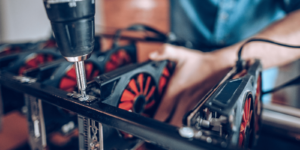What are stable coins? You may have heard this term floating around the cryptocurrency world, but you may not know exactly what they are. In essence, stablecoins are cryptocurrencies that aim to maintain a stable value. This is in contrast to other cryptocurrencies like Bitcoin and Ethereum, which can see their values fluctuate wildly from day to day. So why are stable coins becoming so popular? And how do they work?
Introduction To Stable Coins
Stable coins are a relatively new concept. They are cryptocurrencies whose value is not based on the fluctuating market exchanges, but rather on an outside asset such as gold or fiat currency.
Stablecoins offer users the convenience of cryptocurrency-based transactions without the fear of large price swings that can occur with traditional Bitcoin exchanges.
What makes stablecoins so popular?
Stable coins have become a hot topic of conversation among cryptocurrency investors, and it’s easy to see why. They are digital assets pegged to real-world currencies like the U.S. dollar, Euro, Pound Sterling, and others which means their value remains stable even when the value of other cryptocurrencies goes up or down.
This can help investors manage their risk since they always know that they can redeem the currency for its real-world value.
How many types of stablecoins?
1. Fiat Collateralized Stable coin
These coins include:

USDC(Coinbase)
Fiat Collateralized stable coins, like USDC by Coinbase, are a form of cryptocurrency that uses public blockchain technology to tether its value to underlying real-world fiat currencies, such as the U.S. dollar. This type of stablecoin provides investors and users with trustless, real-time on-chain price stability, allowing them to transact more freely and reliably.
Tether
Tether (USDT) is one of the most well-known fiat-collateralized stable coins, with each USDT unit being supported by reserves of USD held in a designated bank account. This form of backing allows users to buy USDT and store their value without worrying about fluctuations in the market as they would when dealing with standard cryptocurrencies like Bitcoin or Ether.
GUSD(Gemini)
Fiat collateralized GUSD (Gemini) is a new way of digital asset management, offering unparalleled security, transparency, and scalability. Since it’s based on collateralized fiat currency, it eliminates volatility associated with traditional crypto-assets. GUSD truly takes the stress out of digital asset management and provides the highest levels of security somebody would need in today’s fast-paced financial markets.
BUSD(Binance)
BUSD, backed by Binance, is one of the most popular types of this type of stable coin and provides users with the ability to purchase cryptocurrency using a currency they are familiar with – such as U.S Dollars or Euros – and then converting into the crypto asset of their choosing.
2. Crypto-Collateralized Stable coin
A popular type of stablecoin is the crypto-collateralized stablecoin. These coins are backed by a basket of cryptocurrencies which add extra layers of security and stability. This type of stablecoin offers the advantage of being able to access different markets and blockchains while reducing exposure to price volatility since the underlying value remains unchanged regardless of market movement.
3. Algorithmic Stable coin
Algorithmic stablecoins offer an interesting solution to the volatile nature of cryptocurrency and traditional asset fluctuations. By algorithmically adjusting their supply and market prices, they adapt to external economic changes.
Stable coin Regulations
In order to protect consumers and ensure market stability, governments around the world have enacted regulations governing the issuance, trading, and use of these new coins. These rules range from determining minimum capital requirements to prohibiting certain types of transactions and setting transaction limits.
How does Stable coin work?
Each stablecoin is equivalent to one unit of the underlying asset. This provides a layer of certainty and stability within the world of cryptocurrencies, allowing for tangible uses for businesses and customers looking for an alternative to more volatile currencies.
What is the purpose of Stable coin?
1. Accessibility
Using Stablecoin can provide users with numerous potential opportunities, such as providing cash liquidity without going through exchange fees or maintaining value for global transactions. Whether for personal purchases or larger business deals, Stablecoin makes it easier for anyone to access the world’s various digital markets.
2. Speed & Cost
It helps to eliminate fluctuations in prices when trading, making them ideal for merchants and blockchain projects who need rapid and low-cost trades. With their ability to be transferred quickly with very low fees, Stablecoins are becoming increasingly popular for those looking for an efficient way of exchanging funds.

3. Programmable
Stablecoins are an excellent tool for financial institutions looking to provide services utilizing digital assets on a global scale, as well as other businesses seeking an automated solution for secure transactions.
Risks & drawbacks of Stable coins
1. Technical Risk
Besides the benefits of using stablecoins, there are also certain risks and drawbacks associated with them. Technical risk is a primary concern as they are still a relatively new form of digital currency. As the system is based on blockchain technology, the chances of technical failings or breakdowns cannot be completely ruled out.
2. Reserve Risk
One of the main concerns with this form of digital currency is known as reserve risk. This is defined as the pre-defined assets/funds associated with a stablecoin that is used to back its value and potentially lead to it not being able to make good on its promise to remain stable. Depending on the type of asset used for collateral, this could leave some investors open to potential losses.
3. Counterparty Risk
One of the main concerns is counterparty risk, which refers to the potential that a third party appointed to manage the currency might fail financially or otherwise act maliciously. Even if they have been thoroughly vetted, the underlying trust in their service could lead to many unforeseen events, potentially exposing holders of coins to unnecessary economic risks.
4. Security Risk
Perhaps one of the most concern-inducing is the issue of security. Just like any other online form of currency and asset, it’s important that Stablecoin owners have robust protection in place against malicious individuals or groups who may try to steal funds or corrupt data. If such an attack were successful, customers could stand to lose resources and possibly their anonymity if their identities are made known.







